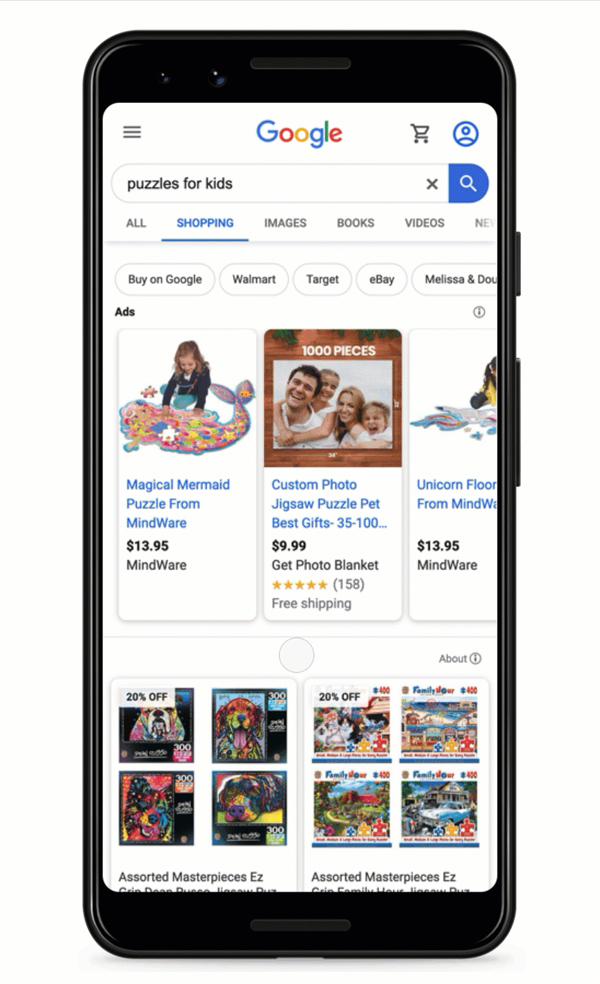Google is taking a major step by opening up its Shopping search results to organic, unpaid listings. From next week, the Google Shopping tab results ‘’will consist primarily of free product listings’’, Google announced on Tuesday. This move comes amid the coronavirus crisis which has forced many brick and mortar retailers to close their outlets. An e-commerce strategy has all of a sudden taken on the urgency of retailers. The coronavirus crisis was the reason for “advancing our plans to make [Google Shopping] free for merchants,” Bill Ready, Google’s President of Commerce stated in a blog post. But the change will be permanent and suits the long-term vision for Google’s role in digital commerce.

“For retailers, this change means free exposure to millions of people who come to Google every day for their shopping needs,” said Ready. “For shoppers, it means more products from more stores, discoverable through the Google Shopping tab. For advertisers, this means paid campaigns can now be augmented with free listings.”
Why Is It Important?
It is an evolution that experts have been following closely and is in different ways the future moment for Google’s product search, which was free earlier before it became a paid product in 2012. Two things have changed in the last few years: Amazon and data quality.
Before it became a paid product, Google’s product search had a quality issue. Listings often lead people to out of stock or a completely different set of items. Google’s ability to make sure that the data in the product feed matches the site’s data has undergone considerable change since then.
And then came Amazon. Google has regarded Amazon as a major competitor in product search and advertising. By reducing the number of products available in Google Shopping results to the retailers who are willing to pay has weakened Google’s influence in search.
By opening up to all merchants, Google’s offering and appeal will draw more retailers and buyers. As in the case of Amazon, sellers want to have good visibility in search results. Now, they will become more competitive with more eligible products to show. They will continue spending on ads. This move adds a new layer to the organic product optimization efforts for SEO professionals and e-commerce marketers.
The new program will work in a way mentioned below.
Distribution of ads and free listings-Paid shopping ads will be visible at the top as well as the bottom of the page on Google Shopping tab, in the same way as they appear on the main search results tab. There can be future layout experiments in the days to come. For instance, Amazon now includes sponsored product ads across its search results pages. The main Google Search page isn’t going to change. The carousels of product listing ads(PLAs) will continue to have ads only.
The Google Shopping hub in America, which was redesigned last fall, will also change the search results pages. The hub’s homepage, which usually includes curated product themes(tech and tools for work, learning, and teaching from home are offerings available at present), will keep on being featured on paid listings only, at least at the outset.
Product Feed-powered-As in the case of ads, the free listings will be powered using product data feeds that are uploaded to Google Merchant Center. Google opened the Merchant Center to all retailers a year ago to allow organic product visibility in different areas of search results, like image search. Recently, Google has started showing organic product listings in a section known as ‘’Popular products’’.
To start, you will have to open a Google Merchant Center and upload a product feed. Sellers need to opt-in to ‘’surfaces across Google’’ to be eligible for organic visibility, Google mentioned in an updated help center article.
Integration of New PayPal-Google has also announced that it was entering into a partnership with PayPal on Tuesday. Merchants utilizing PayPal will now be able to link their accounts to Google Merchant Center, which will let Google add seller details quickly and verify reliable clients. Google also partners with different e-commerce platforms like WooCommerce, Shopify, and BigCommerce to simplify the management of inventory and products for merchants. Google says that this change will come into effect in the US before the end of April and will be expanded across the world by the year-end.





